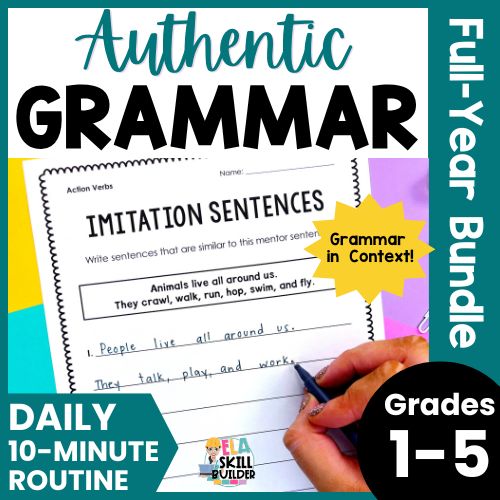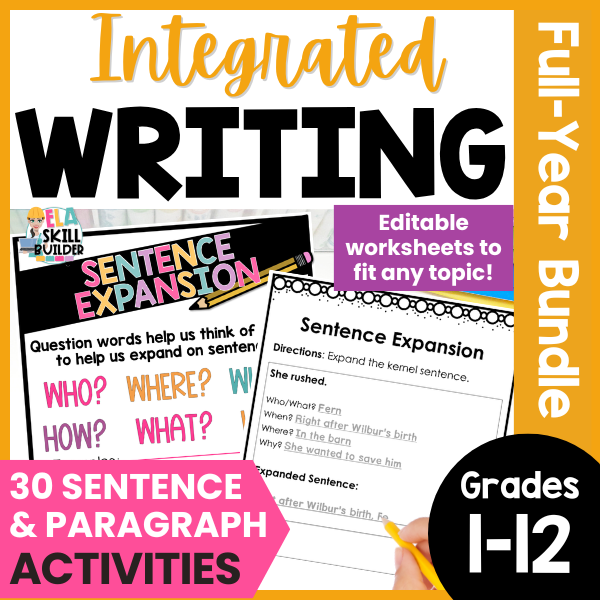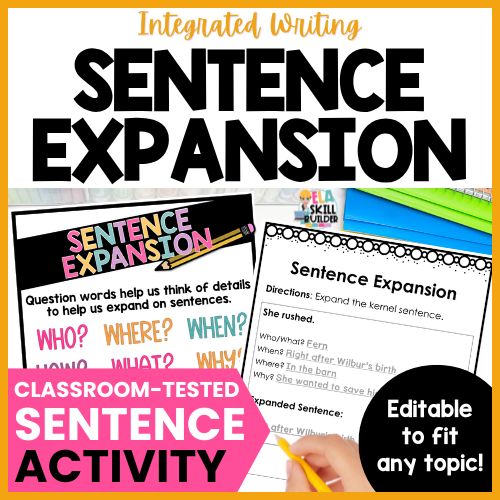
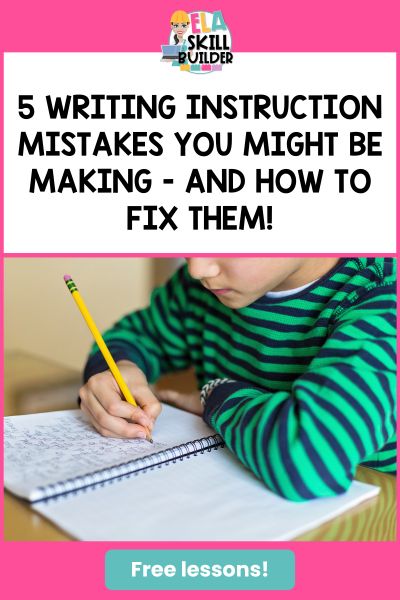
5 Writing Instruction Mistakes You Might Be Making – And How to Fix Them!
Did you know writing is one of the most dreaded subjects to teach in elementary classrooms?
You’re juggling time limits, behavior, student needs, curriculum, and the pressure to boost scores – all while trying to turn a room full of kids into confident writers. It’s a lot!
If you’ve ever felt like your writing block just isn’t working, you’re definitely not alone. Most teachers are doing the best they can, often without the tools or training they really need.
The truth is, many of us are making a few common mistakes when it comes to writing instruction. These mistakes are easy to fall into, and I’ve made them myself.

Here are a few signs your writing time might not be working as well as it could:
- You feel rushed and rarely finish a full writing lesson
- Your students lose focus quickly or say, “I don’t know what to write”
- Your writing curriculum feels overwhelming or hard to follow
- You’re stretched thin trying to meet the needs of all learners
- Your students aren’t improving as quickly as you hoped
- Grammar lessons don’t seem to carry over into writing
- It feels chaotic when students are all at different steps in the writing process
If you’re nodding your head, you’re in the right place. In this post, I’ll walk you through five common writing instruction mistakes – and simple, realistic ways to fix them.
Mistake #1: Assigning Writing Without Explicitly Teaching Skills
It might seem like the more students write, the better writers they’ll become. But simply assigning more writing tasks isn’t enough.
In fact, a recent two-year study with young children in Norway found that simply having students write more did not improve the quality of their writing.
While daily writing is important, students don’t improve simply by writing more – they improve when they receive explicit instruction on how to write better.
This mirrors what happened in reading before the Science of Reading movement. For years, teachers encouraged kids to read lots of books, assuming reading more would make them better readers.
But research showed students needed structured, explicit instruction in phonics, vocabulary, and comprehension. The same applies to writing.
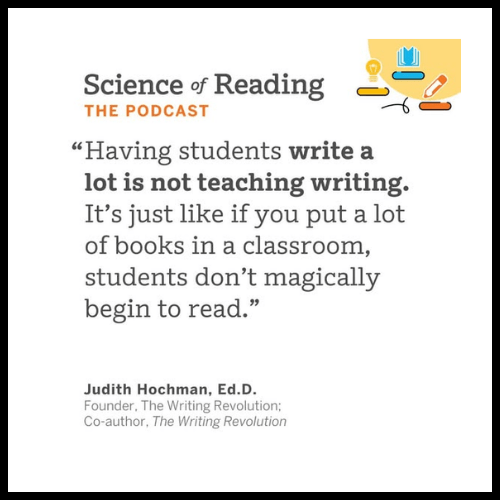
Students don’t automatically know how to write a strong sentence, use details, or organize ideas just because they’re told to write a paragraph. They need focused instruction on specific skills, with clear modeling from the teacher. They need to see how to plan, draft, revise, and edit – and get plenty of guided and independent practice with support.
Slowing down and teaching writing explicitly gives students the tools they need to grow. Writing becomes less frustrating and more successful for everyone.
What to Do Instead
Instead of assigning lots of writing tasks without clear direction, focus on explicitly teaching writing skills through structured lessons.
Break the writing process into manageable steps and concentrate on one skill at a time so students can absorb and practice each part fully.
Modeling is key. Show students how to plan, draft, revise, and edit by thinking aloud as you write and using mentor texts to highlight examples of the skills you want them to learn.
Give students opportunities to try out each skill in their own writing, offering support and guidance as they practice. This builds their confidence and helps them understand what quality writing looks like.
Encourage regular, purposeful writing that focuses on applying taught skills instead of writing without clear direction. Explicit, scaffolded instruction helps students build strong habits and a deeper understanding of how to improve, making writing more meaningful and boosting their confidence as writers.
Mistake #2: Trying to Cram Too Much in One Class Period
One of the biggest mistakes teachers make is trying to cram too much into a single writing lesson. You might try introducing a new genre, modeling a hook, reminding students about subject-verb agreement, and squeezing in independent writing time – all in one short block.
When too many skills are packed into one writing block, students can’t focus. They get overwhelmed or frustrated. Instead of strong writers, we get students rushing to finish, with writing that lacks structure, voice, or clear ideas.
Writing can’t and shouldn’t be rushed.
What to Do Instead
Focus on teaching one skill each day. Begin with a visual anchor chart that clearly explains the skill to help students understand and remember it. Then, show how the skill appears in a mentor text by reading a short example and highlighting how the author uses it effectively.
Next, model the skill in your own writing. Think aloud as you write a sentence or two, explaining how you are applying the targeted skill in your writing. Finally, give students the opportunity to practice the skill in their own writing.
This approach makes your lessons more meaningful and gives students the time they need to grow as writers, one step at a time.
Example Daily Mini-Lessons for Each Stage:
Prewriting:
- How to brainstorm strong topic ideas
- Organizing ideas using a graphic organizer
- Choosing a small moment to zoom in on
Drafting:
- Writing a strong introduction
- Using transition words
- Using dialogue
Revising:
- Substituting boring words for specific words to enhance writing
- Rewriting sentences for clarity
- Using a checklist to improve word choice or sentence variety
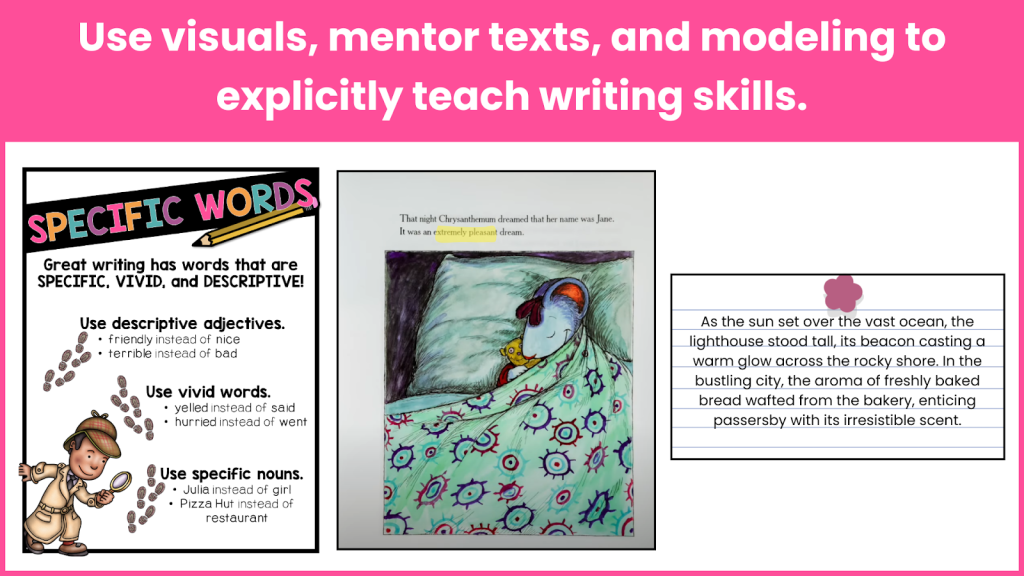
Editing:
- Checking for capital letters and punctuation
- Fixing run-on sentences
- Using editing partners and checklists
Publishing:
- Rewriting and fixing errors
- Celebrating finished pieces through read-alouds or displays
When you slow down and keep mini-lessons focused, students learn what to do and get time to try it. Their writing improves because they understand each skill more clearly. When instruction isn’t rushed, students gain confidence and apply what they’ve learned with purpose.
Mistake #3: Rushing Through the Writing Process
I used to feel like I had to rush my students through the writing process. I thought they needed to produce a full writing piece in just one or two weeks so I could fit everything in.
But that fast pace meant I didn’t have time to teach writing skills clearly or give students time to actually master them.
I also used to let students move through the writing process at their own pace. Some were still brainstorming while others had already started revising. It quickly became chaotic. Students grew confused or frustrated, constantly asking, “What do I do next?” I spent most of the block moving from student to student, answering questions.
Then I learned a simple strategy that changed everything: move through the writing process as a class, one stage at a time. When we went through prewriting, drafting, revising, editing, and publishing together, everything became more manageable. Students felt more supported, and I had more time to teach each part of the process clearly.
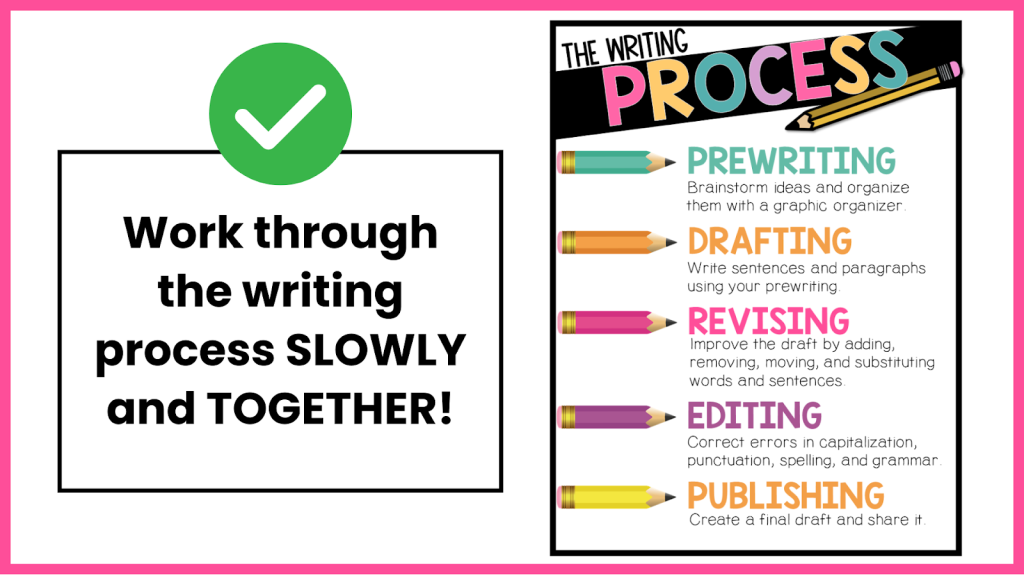
What To Do Instead
Guide your class through each stage of the writing process together. Slow things down and plan to spend several days on each stage, using daily mini-lessons to focus on just one skill at a time.
Ideally, spend about one week on prewriting, one to two weeks on drafting, one week on revising and editing, and one week on publishing. For each mini-lesson, teach one specific skill using a visual anchor chart, show examples in a mentor text, model it in your own writing, and then have students practice it in their own work.
When everyone is working on the same stage, it’s easier to provide support, check for understanding, and make sure students are applying the skills you’ve taught. You can scaffold instruction more intentionally, and your classroom becomes much easier to manage.
As teachers, we often feel like students need to write a lot of full pieces throughout the year. But the truth is, quality matters more than quantity. Students grow most when we give them focused, explicit writing instruction and time to truly practice each skill. When we stop rushing and start teaching writing step by step, we help students become stronger, more confident writers.
Benefits of Working Through the Process Together:
- You create a more supportive writing community.
Working through the process together encourages collaboration, shared learning, and a sense of success for everyone.
- You can teach specific skills clearly and intentionally.
When everyone is working on the same step, you can model each part of the process and give students immediate practice with the skill you’re teaching.
- It’s easier to manage your classroom.
With the whole class focused on the same task, there are fewer distractions and less confusion about what to do
- You get a better picture of student progress.
It’s easier to see who is getting it and who needs more support – no one slips through the cracks.
- Students build confidence and write with more purpose.
Slowing down helps them fully understand what they’re doing, which leads to stronger, more thoughtful writing.
Mistake #4: Allowing Students to Write on Any Topic
For years, teachers were encouraged to make writing time as student-led as possible. For example, teachers were encouraged to let students choose their own topics for their writing pieces. While that sounds ideal in theory, it’s tough to manage in a real classroom.
Take informational writing, for example. When students pick any topic, some choose topics they know little about. Without enough background knowledge, it’s hard to write clearly or with detail. And when every student is working on something different, it becomes nearly impossible to give focused feedback or keep the class moving forward together.
Research shows that while student voice and choice are important, kids also need structure and explicit instruction to grow as writers. Too much freedom can actually cause frustration and lead to weaker writing.

What To Do Instead
- Tie writing topics to your curriculum. Provide writing topics that are connected to your current science, social studies, or reading units. This builds on what students already know and makes writing more meaningful.
- Offer a limited set of familiar topics. Provide 3–5 topic options that students already have some knowledge of. This allows for choice while still providing structure.
- Model how to choose a topic. Think aloud as you select a topic from a list, explaining how you pick something you know well and can write a lot about.
This kind of structure doesn’t limit creativity – it supports it. When students feel confident in their topic and understand the expectations, they’re much more likely to write with focus and depth.
Mistake #5: Teaching Grammar Separately from Writing
I used to teach grammar completely separate from writing. Honestly, my grammar lessons often took over the entire writing block. I’d introduce a grammar skill, have students practice it with a worksheet or a game, and then call it a day.
But over time, I noticed two major problems with this approach. First, I didn’t leave enough time to actually teach writing. Second, my students rarely applied those grammar skills in their writing.
Years later, through my own research, I realized what I had been doing wrong: I was teaching grammar in isolation from writing.
What to Do Instead
Research shows that grammar is most effective when taught in the context of writing. This means integrating grammar instruction into your writing block – but without letting grammar take over the whole time.
Your grammar teaching should be brief, about 10 to 15 minutes, and tied directly to writing through meaningful, authentic activities.
Here’s a sample schedule you can use during your writing block to balance both grammar and writing instruction:
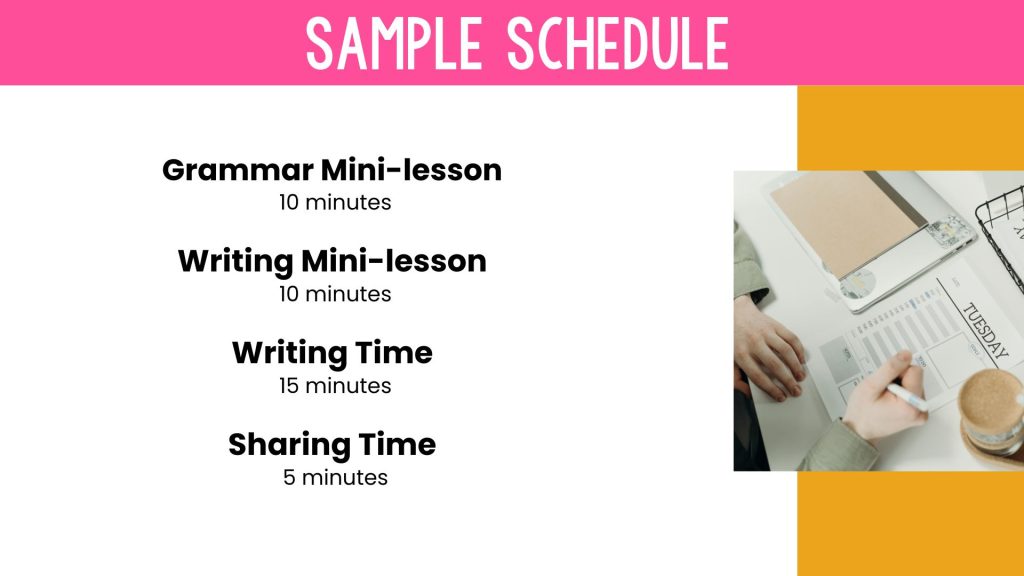
One strategy that works really well for teaching grammar in the context of writing is using mentor sentences. These are sentences taken from well-written books or even student writing that clearly demonstrate a particular grammar skill. For example, if you want to teach subject-verb agreement, you might choose a mentor sentence like:
“The dog barks loudly every morning.”
Students analyze this sentence to notice how the singular subject “dog” matches the singular verb “barks.” Then, they try an imitation sentence activity where they write their own sentences following the same pattern, such as:
“The cat jumps high on the sofa.”
This kind of activity helps students practice grammar in a way that is meaningful and connected to real writing. It shows them how grammar functions within sentences instead of as isolated rules to memorize.
Teachers who use this approach often see big improvements in their students’ writing. When grammar instruction is woven naturally into writing lessons, students don’t just learn the rules – they actually apply them. This makes their writing stronger and more confident overall.
Try This: FREE Prewriting Lessons for Narrative Writing
Ready to try a more focused, step-by-step approach for teaching writing? Grab my 5 Narrative Prewriting Lessons that guide students through the prewriting stage one skill at a time. With just one targeted skill each day, you’ll build their confidence and set them up for narrative writing success—without the overwhelm.
Click here to grab 5 free prewriting lessons for a narrative unit!
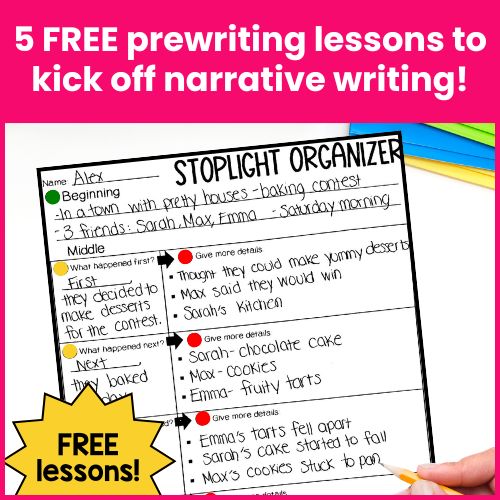
Conclusion
If you’ve been feeling overwhelmed by your writing block or just plain unsatisfied with the results, you’re not alone. Many of us were taught outdated methods or expected to figure it out as we went. The good news is that small changes can lead to big results.
By fixing the five common mistakes we covered in this post, you can go from feeling scattered and frustrated to having a clear, manageable plan. Your lessons will be more focused. Your students will grow more confident. And writing time will become something you actually look forward to.
About Jen Goasdone
Jen Goasdone, the owner of ELA Skill Builder, is a dedicated educator committed to empowering teachers with simple, research-based strategies for effective writing instruction. With a focus on making ELA teaching easier and more impactful, Jen helps students build a strong writing foundation that will serve them for years to come. Passionate about both teacher and student success, she strives to make writing instruction enjoyable and effective for elementary students.
Related Posts


Hey Teachers,
I'm Jen from
ELA Skill Builder!
My mission is to empower elementary teachers like you with the tools and confidence to teach writing effectively, so your students can grow into strong, capable writers.
Best Sellers!
Writing resources
Features explicit writing workshop lessons for narrative, informational, and opinion writing.
Grammar resources
Features a simple weekly routine that teaches grammar in context in just 10 minutes a day.
writing prompts
Features 810 prompts designed to strengthen paragraph writing skills all year long!
cross-curricular writing
Features 30 sentence and paragraph activities inspired by The Writing Revolution that fit any subject.
coupon code
Get 15% off Your First Purchase
free lessons!
Grab 5 free prewriting lessons to kick off your narrative writing unit – all materials included!
jOIN A COMMUNITY
writing training
Features 4 hours of video lessons designed to help you run a structured, effective, and engaging writing block.
free gramamr routine!
Features a free 5-day routine for teaching any grammar skill in context, in just 10 minutes a day!
free SENTENCE ACTIVITY
Features a free, editable sentence activity that helps students expand sentences for any topic.
contact jen!
Got questions? Fill out this contact form, and I’ll get back to you as soon as possible.




